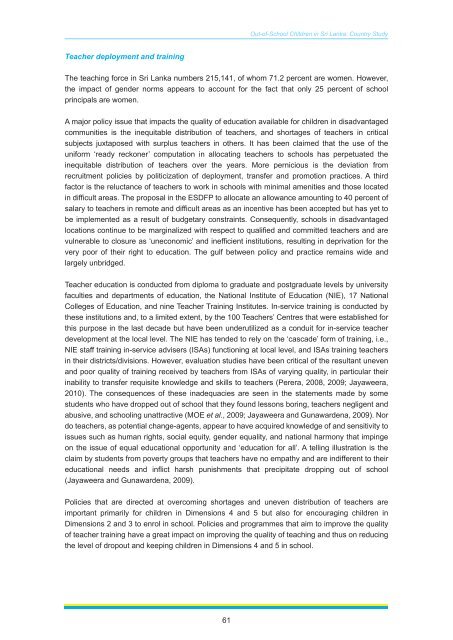Sri Lanka - Institut de statistique de l'Unesco
Sri Lanka - Institut de statistique de l'Unesco
Sri Lanka - Institut de statistique de l'Unesco
Create successful ePaper yourself
Turn your PDF publications into a flip-book with our unique Google optimized e-Paper software.
Out-of-School Children in <strong>Sri</strong> <strong>Lanka</strong>: Country Study<br />
Teacher <strong>de</strong>ployment and training<br />
The teaching force in <strong>Sri</strong> <strong>Lanka</strong> numbers 215,141, of whom 71.2 percent are women. However,<br />
the impact of gen<strong>de</strong>r norms appears to account for the fact that only 25 percent of school<br />
principals are women.<br />
A major policy issue that impacts the quality of education available for children in disadvantaged<br />
communities is the inequitable distribution of teachers, and shortages of teachers in critical<br />
subjects juxtaposed with surplus teachers in others. It has been claimed that the use of the<br />
uniform ‘ready reckoner’ computation in allocating teachers to schools has perpetuated the<br />
inequitable distribution of teachers over the years. More pernicious is the <strong>de</strong>viation from<br />
recruitment policies by politicization of <strong>de</strong>ployment, transfer and promotion practices. A third<br />
factor is the reluctance of teachers to work in schools with minimal amenities and those located<br />
in difficult areas. The proposal in the ESDFP to allocate an allowance amounting to 40 percent of<br />
salary to teachers in remote and difficult areas as an incentive has been accepted but has yet to<br />
be implemented as a result of budgetary constraints. Consequently, schools in disadvantaged<br />
locations continue to be marginalized with respect to qualified and committed teachers and are<br />
vulnerable to closure as ‘uneconomic’ and inefficient institutions, resulting in <strong>de</strong>privation for the<br />
very poor of their right to education. The gulf between policy and practice remains wi<strong>de</strong> and<br />
largely unbridged.<br />
Teacher education is conducted from diploma to graduate and postgraduate levels by university<br />
faculties and <strong>de</strong>partments of education, the National <strong>Institut</strong>e of Education (NIE), 17 National<br />
Colleges of Education, and nine Teacher Training <strong>Institut</strong>es. In-service training is conducted by<br />
these institutions and, to a limited extent, by the 100 Teachers’ Centres that were established for<br />
this purpose in the last <strong>de</strong>ca<strong>de</strong> but have been un<strong>de</strong>rutilized as a conduit for in-service teacher<br />
<strong>de</strong>velopment at the local level. The NIE has ten<strong>de</strong>d to rely on the ‘casca<strong>de</strong>’ form of training, i.e.,<br />
NIE staff training in-service advisers (ISAs) functioning at local level, and ISAs training teachers<br />
in their districts/divisions. However, evaluation studies have been critical of the resultant uneven<br />
and poor quality of training received by teachers from ISAs of varying quality, in particular their<br />
inability to transfer requisite knowledge and skills to teachers (Perera, 2008, 2009; Jayaweera,<br />
2010). The consequences of these ina<strong>de</strong>quacies are seen in the statements ma<strong>de</strong> by some<br />
stu<strong>de</strong>nts who have dropped out of school that they found lessons boring, teachers negligent and<br />
abusive, and schooling unattractive (MOE et al., 2009; Jayaweera and Gunawar<strong>de</strong>na, 2009). Nor<br />
do teachers, as potential change-agents, appear to have acquired knowledge of and sensitivity to<br />
issues such as human rights, social equity, gen<strong>de</strong>r equality, and national harmony that impinge<br />
on the issue of equal educational opportunity and ‘education for all’. A telling illustration is the<br />
claim by stu<strong>de</strong>nts from poverty groups that teachers have no empathy and are indifferent to their<br />
educational needs and inflict harsh punishments that precipitate dropping out of school<br />
(Jayaweera and Gunawar<strong>de</strong>na, 2009).<br />
Policies that are directed at overcoming shortages and uneven distribution of teachers are<br />
important primarily for children in Dimensions 4 and 5 but also for encouraging children in<br />
Dimensions 2 and 3 to enrol in school. Policies and programmes that aim to improve the quality<br />
of teacher training have a great impact on improving the quality of teaching and thus on reducing<br />
the level of dropout and keeping children in Dimensions 4 and 5 in school.<br />
61

















